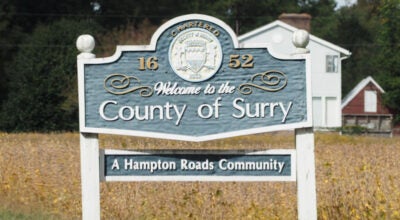Bald-faced hornets: The good, the bad, the beautiful
Published 2:22 pm Tuesday, November 7, 2023

- The bald-faced hornet can inflict pain when it stings. (Submitted photo)
By Linda Byrd-Masters
Virginia Master Naturalist HSS
Recently, a friend texted me a photo of a large, circular gray object embedded into a bush and asked me what this was. With its wavy, artistic exterior and massive size, it was quite impressive. Looking more closely, I noticed a quarter sized hole with a couple of large black and white-faced insects peering out. Yes, this was the nest of a colony of bald-faced hornets, and my immediate reply to her was danger, stay away.
The bald-faced hornet is not actually a hornet, but closely related to yellow jackets. It is usually thought of more like a hornet because of its one-inch size and high aerial nests.
Bald-faced hornets are social wasps, meaning they live in large colonies as those of ants and honey bees. Only queens survive the winter, and in early spring, a lone queen will start a small nest where she lays and fertilizes infertile females that become workers. Occasionally, she skips fertilizing a cell and creates drones, the males that may mate with the queen. In late summer, the nest is filled with both males and eventually fertile females to become the next season’s queens.
The nest is quite a meticulous feat of engineering. Made from paper-like material created by mixing chewed wood with saliva, it contains many tiers of cells and can hold hundreds of eggs and workers. The outer shell reveals exquisite circular patterns. At the top, small holes allow for heat to be released but keep the rain out. Usually the size of basketballs, nests have been observed to be as large as three feet in diameter. Most often, they are located in wooded areas but sometimes show up on shrubs, poles, or house siding.
Bald-faced hornets deliver a potent, toxic-laden sting, and since they have smooth stingers, they can sting multiple times on a target. If they believe their nest is threatened, they will swarm and inflict pain to interpreted invaders, including people and pets.
So, should nests be destroyed? As with any living creature, they have their place in the natural order of things. Bald-faced hornets are beneficial insects, feeding on grasshoppers, caterpillars and soft-sided insects. In late summers, they are pollinators. Despite their defenses, they are food for birds and small animals.
Most of the time, we do not even know the nests are nearby as they usually build in the branches of trees well above our heads; it is only in the fall when leaves die away do we realize we have been living in harmony with a colony. However, when an ill-placed nest presents a real danger to humans and pets, then yes, it should be removed. The Internet provides ways for the do it yourself folks, however, it is far better advised to call a local exterminator and leave such a task to the pros.
Virginia Cooperative Extension programs and employment are open to all, regardless of age, color, disability, gender, gender identity, gender expression, national origin, political affiliation, race, religion, sexual orientation, genetic information, veteran status, or any other basis protected by law. An equal opportunity/affirmative action employer. Issued in furtherance of Cooperative Extension work, Virginia Polytechnic Institute and State University, Virginia State University, and the U.S. Department of Agriculture cooperating. Edwin J. Jones, Director, Virginia Cooperative Extension, Virginia Tech, Blacksburg; M. Ray McKinnie, Administrator, 1890 Extension Program, Virginia State University, Petersburg.





